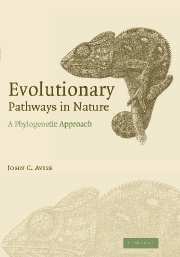Book contents
- Frontmatter
- Contents
- Preface
- Acknowledgments
- 1 Introduction
- 2 Anatomical structures and morphologies
- 3 Body colorations
- 4 Sexual features and reproductive lifestyles
- 5 More behaviors and ecologies
- 6 Cellular, physiological, and genetic traits
- 7 Geographical distributions
- Epilog
- Appendix: a primer on phylogenetic character mapping
- Glossary
- References and further reading
- Index
Preface
Published online by Cambridge University Press: 18 December 2009
- Frontmatter
- Contents
- Preface
- Acknowledgments
- 1 Introduction
- 2 Anatomical structures and morphologies
- 3 Body colorations
- 4 Sexual features and reproductive lifestyles
- 5 More behaviors and ecologies
- 6 Cellular, physiological, and genetic traits
- 7 Geographical distributions
- Epilog
- Appendix: a primer on phylogenetic character mapping
- Glossary
- References and further reading
- Index
Summary
Many biologists now incorporate molecular phylogenetic analyses into their explorations of nature. Using sophisticated laboratory techniques, they uncover “DNA markers” or “genetic tags” that uniquely identify each creature. Furthermore, details in the submicroscopic structures of these natural labels offer tantalizing clues to how living organisms were genealogically linked through bygone ancestors. Thus, lengthy DNA sequences housed in the cells of all organisms carry not only the necessary molecular genetic instructions for life, but also extensive records of phylogeny, i.e. of evolutionary ancestry and descent.
During the replication and transmission of DNA from one generation to the next, mutations continually arise. Many of these spread through populations (via natural selection, or sometimes by chance genetic drift), thereby cumulatively altering particular molecular passages in each species' hereditary script. In recent years, scientists have learned how to read and interpret the genealogical content of these evolutionary diaries – these “genomic autobiographies” – of nature. Results are summarized as phylogenetic diagrams that depict how particular forms of extant life are connected to one another via various historical branches in the Tree of Life.
Phylogenetic analysis has become a wildly popular exercise in many areas of biology, but phylogenies estimated from DNA sequences are seldom the ultimate objects of scientific interest. The primary value of each molecular phylogeny lies instead in its utility as historical backdrop for deciphering the evolutionary histories of other kinds of biological traits such as morphologies, physiologies, behaviors, lifestyles, or geographical distributions.
- Type
- Chapter
- Information
- Evolutionary Pathways in NatureA Phylogenetic Approach, pp. ix - xPublisher: Cambridge University PressPrint publication year: 2006



